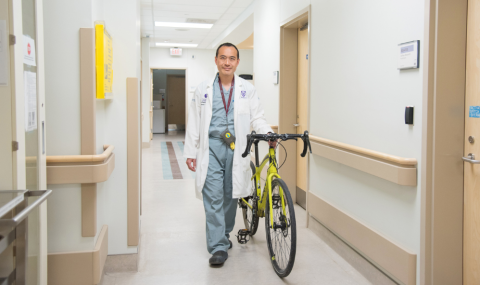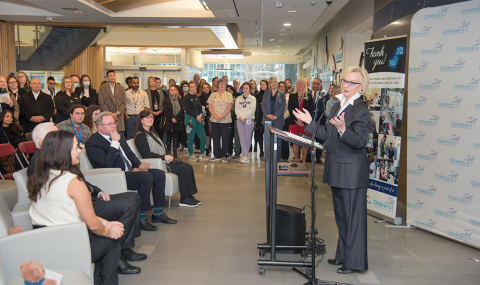| Procedure |
Rationale |
| 1.Measurement of C.O. with a right heart catheter is done using thermodilution technique, where temperature is the detected change. |
1.Injection of a predetermined amount of fluid, at a known T., into C.V.P. port provides the temperature change/change in time signal that the computer analyzes to calculate CO. |
| 2.Cold cardiac outputs are measured using 10 mL of 6-12oC D5W. Variations in volume, catheter, or temperature may require a change to the constant used (see chart for cardiac output constants). |
2.Constants vary depending on volume used, catheter type, and temperature of injectate. |
| 3.Ensure that you have the CO-Set for cold cardiac output measurements. |
3.The CO-Set for cold is a different circuit than the room temperature set up. |
| 4.Pack the container with crushed ice up to the inside ridge in the internal ribs. |
4.It is difficult to put ice in this section when the coils are in place. |
| 5.Place the cooling coil on the first ridge in the styrofoam container. Be sure that the white plastic square is inside the container. |
5.Proper placement of the coil will allow D5W to cool to the appropriate temperature as it flows through the tubing. |
| 6.Completely cover the cooling coil with crushed ice. |
6.To cool the D5W to 6-12oC. |
| 7.Add COLD water until it is visible above the ice level. |
7.To make ice slush solution for cooling D5W. |
| 8.Place any unused length of tubing coil into the ice container. The 500 ml bag of D5W must be on the outside of the container. |
8.To provide additional cold solution. The D5W will be too cold if the 500 ml bag is in the container. |
| 9.Lock the lid on the cooling container. (You should be able to read "CO-Set" on the lid when it is properly placed).
*Note: use the spigot to drain excess water from the melting ice before refilling.
|
9.A covered ice bath should remain useable for up to 6 hours. Check periodically to ensure ice is still present. |
| 10.The system should reach operating temperature within 5 minutes. |
10.Allow set-up to sit a minimum of 5 minutes before injection. |
| 11.Establish that an order has been written. (Preprinted standard orders apply) |
11.An order is required to perform this test. |
| 12.Evaluate solution infusing into injection port. |
12.Continual infusions that support CO or BP, should not be infused via injection port. The nurse MAY NOT perform cardiac output measurements in this case. |
| 13.Re-zero transducer and obtain remaining H.D. measurements before doing C.O. (C.V.P. and wedge). |
13.PWP may be transiently higher post injections. Consistency in measurement technique is important when interpreting results. |
| 14.Be aware that very rapid (more than 100 mL/hour) infusions into any other ports may alter results. |
14.The blood temperature may be decreased by rapid infusion of room temperature I.V. solutions and the change in temperature may not be enough for the thermistor to sense. |
| 15.Before doing cardiac outputs, establish that the right heart catheter shows a good pulmonary artery waveform. |
15.Cardiac outputs done with improper position of right heart catheter may yield inaccurate measurements. |
| 16.Perform hand hygiene. Don non-sterile gloves when drawing blood samples. |
16.In accordance with the MoHLTC 4 moments of hand hygiene and LHSC infection control policies. |
| 17..Connect CO module into Datex monitor and clip the injectate temperature probe to Closed Injectate flow-through housing (see diagram).
Touch "CO/wedge/SvO2" button on menu.
|
17.This is the interface for information transfer from the catheter to the monitor. |
| 18.**Ensure computation constant is correct according to type of catheter, volume used, and injectate T. |
18.Constant adjustment is essential to ensure computer "knows" the length from C.V.P. port to distal tip, the temperature drop and dilution. Wrong constants will cause incorrect measurements. |
| 19.Turn CVP injectate port infusions off. |
19.The infusion sits between the injectate and patient. Any variation between the temperatures of the CVP infusion and the cardiac output injectate would alter temperature after injectate temperature is measured. |
| 20.Unclamp the D5W line of the Closed Injectate Delivery System. |
20.Filling will begin automatically upon release of clamp. |
| 21.Withdraw 10 mL of D5W into the syringe. Close the clamp as soon as filling is complete.
Note: if you pull back on the syringe plunger too hard the plunger can actually be pulled out of the syringe. Be careful not to over fill.
|
21.When the clamp is opened, the syringe will continue to fill.
D5W is the required solution because calculation of cardiac output is based on the specific gravity and temperature of blood, and specific gravity and temperature of D5W (NaCl has a different specific gravity).
A one way valve prevents aspiration of blood or backward flow during syringe filling.
|
| 22.Press start CO.Inject when monitor displays "Inject Now". |
22.To activate program. |
| 23.Perform injection as exhalation begins. If the patient is receiving any mechanical ventilation, perform the injection with a mechanical breath. |
23.Allows for minimal variation related to different phases of the respiratory cycle. Venous return and filling pressures change at various points of the respiratory cycle. Mechanical breaths will have the greatest influence. |
| 24.Immediately inject entire syringe volume using a steady, continuous pressure. Deliver contents within 4 seconds. |
24.Steady, controlled delivery is necessary to produce an accurate temperature change curve. |
| 25.Identify injectate T. |
25.Calculation of cardiac output depends on the difference between patient's blood temperature and injectate temperature.
Injection must take place in order to detect temperature accurately.
|
| 26.Ensure that the temperature of the injectate is between 6-12oC. |
26.To ensure temperature is within range. |
| 27.Perform a minimum of 3 measurements and obtain the average.
Space injections approximately 1 minute apart.
Discard all samples with a variance of more than 10% from other measurements.
Discard samples with a poor quality curve by editing, then averaging results. Remove inaccurate CO by scrolling to "Edit results", once this is complete press "average all", then it will ask you to press "confirm".
|
27.Waiting a minute between injections permits blood temperature to return to normal between measurments.
To prevent averaging in inaccurate results.
|
| 28.Remove the Flow-Through temperature probe from the housing. |
28.To prevent damage to cable during patient turning etc. |
| 29.Open IV stopcock and restore infusion rate. |
29.To ensure IV therapy resumes and line patency is maintained. |
| 30.Ensures PAP tracing is present on monitor when completed. |
30.To establish catheter placement has not been altered. |
| 31. Remove non-sterile gloves and perform hand hygiene. |
31. In accordance with the MoHLTC 4 moments of hand hygiene and LHSC infection control policies. |
| 32.Simultaneous measurements are important when calculations for oxygen extraction, O2 delivery, and O2 consumptions are done. Oxygen delivery for example is calculated as C.O. x Arterial Oxygen Content, the assumption is that all factors in the equation reflect the same time and condition.
Unless bleeding, Hb does not change very quickly. Hb is needed to calculate oxygen content and therefore any values using oxygen content.
Lactates are invalid if a tourniquet is applied as the distal limb would produce increased lactic acid.
|
32.Obtain venous and arterial gases, lactate and Hb. Both gases must be drawn within 5 minutes of cardiac output measurement. The same conditions must exist during cardiac output and blood gas measurements (ie. head of bed at same level, same oxygen concentration and same amount of ventilation).
Unless actively bleeding, the Hb should be drawn within 4 hours of the Cardiac output measurement.
The lactate should be drawn within 4 hours of the cardiac output measurement. Either an arterial or venous lactate may be sent. Venous lactates must be drawn from an indwelling catheter (no tournequet).
|
| 33.Identify B.S.A. using B.S.A. guide. |
33.Cardiac index standardizes the body surface area so that the normal range for CI is the same for all patients. |
| 34.Identify the patient's FI02. |
34.FI02 is needed for the computer to calculate shunt (QS/QT). |
|
35.Enter the collected data into the CCTC computer program
"Critbase".
|
35.Critbase will calculate the pre-programmed equations for the desired hemodynamic variables and oxygen transport indices. |
| 36.Double check the data you have entered on the hemodynamic profile for typographical errors. |
36.Since most of the values are calculated by the entered information, incorrect data will result in multiplied errors for the calculated values. |
| 37.Have the results reviewed by the physician. |
37.To determine therapy and communicate results. |
| 38.Place profile on the back of the physician's clinical notes and record appropriate hemodynamic data onto flowsheet. |
38.To record and communicate data. |
| 39.Be sure you have signed the hemodynamic profile. |
39.To identify person who took the measurements. |


